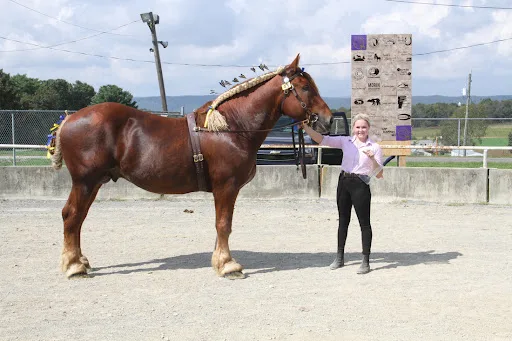When you picture a horse from the old English countryside—strong, broad-shouldered, pulling a plow through golden fields—you might be imagining the Suffolk Punch.
This powerful draft horse, known for its chestnut coat and calm demeanor, is one of the oldest and purest of England’s heavy horse breeds. While it doesn’t get as much media attention as some flashier breeds, the Suffolk Punch has long been admired for its strength, work ethic, and gentle nature.
Sadly, this iconic breed is now critically endangered, with fewer than a few hundred breeding animals worldwide. But its legacy—and its importance—remains as solid as the horses themselves.
Let’s take a closer look at this noble worker of the fields.
A History Rooted in the Soil
The Suffolk Punch dates back to the early 1500s in Suffolk, a rural county in eastern England. The breed was developed by farmers who needed a powerful, durable horse to work the land—plowing, harrowing, and hauling heavy loads. These were horses built not for show but for service.
What’s remarkable about the Suffolk Punch is the consistency of its bloodline. The breed can be traced back to a single stallion born in 1768, and for centuries, breeders have prioritized practical traits: strength, stamina, and good temperament.
Unlike some draft breeds that were also used for pulling carriages or ceremonial roles, the Suffolk Punch was a true farm horse through and through—designed for long days in the fields.
What’s in a Name?
The term “Punch” refers to the horse’s stocky, powerful build. These horses are compact but muscular—shorter and more rounded than their cousins, the Shire or Clydesdale. Their shape is built for traction and endurance rather than speed or elegance.
The breed is sometimes also called the Suffolk Horse, but “Suffolk Punch” remains the most commonly used name, especially in reference to its traditional working role.
Breed Characteristics: Strength with Style
The Suffolk Punch is easy to recognize, thanks to a combination of features that make it stand out among draft breeds.
Size and Build:
- Height: Usually between 16.1 to 17.2 hands.
- Weight: Around 1,900 to 2,200 pounds.
- Build: Broad-chested, deep-bodied, with a short, muscular neck and strong hindquarters. They are built like tractors—powerful and purposeful.
Color:
- Always chestnut—but interestingly, the breed recognizes seven distinct shades, from light golden to dark liver chestnut. No other colors are permitted for registration.
Temperament:
- The Suffolk Punch is known for being calm, willing, and extremely gentle. Despite their size, they are easy to handle and often described as “honest workers.” They are steady, cooperative, and less prone to flightiness than some lighter breeds.

A Life of Labor
For centuries, Suffolk Punch horses were the backbone of British agriculture. Their strong build and tireless nature made them ideal for heavy farm work, from tilling soil to pulling carts loaded with crops or timber.
Unlike other draft breeds that were sometimes used in urban settings, Suffolk Punches were almost exclusively rural workers. Their reliability and low-maintenance nature made them invaluable to farmers across England.
However, with the rise of tractors and mechanized farming in the 20th century, the need for heavy horses declined sharply. By the mid-1900s, the breed was in danger of disappearing altogether.
Endangered but Not Forgotten
Today, the Suffolk Punch is listed as a critically endangered breed by organizations like the Rare Breeds Survival Trust in the UK and The Livestock Conservancy in the US. It is estimated that there are fewer than 500 breeding mares globally.
Conservation efforts are underway in both the UK and the US to save the breed. Enthusiasts, breeders, and agricultural organizations are working together to raise awareness, encourage responsible breeding, and find modern uses for these incredible horses.
Some of the current uses for Suffolk Punch horses include:
- Timber hauling in sensitive forest areas where machines can’t go.
- Organic and sustainable farming, where horse-drawn equipment is making a comeback.
- Public demonstrations and heritage events, helping to educate the public about traditional farming.
- Therapeutic and recreational riding (in lighter work), thanks to their gentle nature.
Why the Suffolk Punch Matters
The Suffolk Punch is more than just a draft horse—it’s a symbol of agricultural heritage, resilience, and natural power. Its survival isn’t just about preserving a breed; it’s about holding on to a way of life where harmony with nature and hard, honest work were central values.
With the right attention and support, there’s hope for the Suffolk Punch. And in a world increasingly interested in sustainability, the idea of farming with horsepower—literal horsepower—might just be making a quiet comeback.
Final Thoughts
The Suffolk Punch may not gallop across racetracks or dazzle in Olympic arenas, but it has something just as important: a deep-rooted history, an unshakable work ethic, and a connection to the land that shaped it. These horses are reminders of a time when human and animal worked side by side—not for speed or spectacle, but for survival and harvest.
They are, in every sense, gentle giants—deserving not just of admiration, but of preservation.

